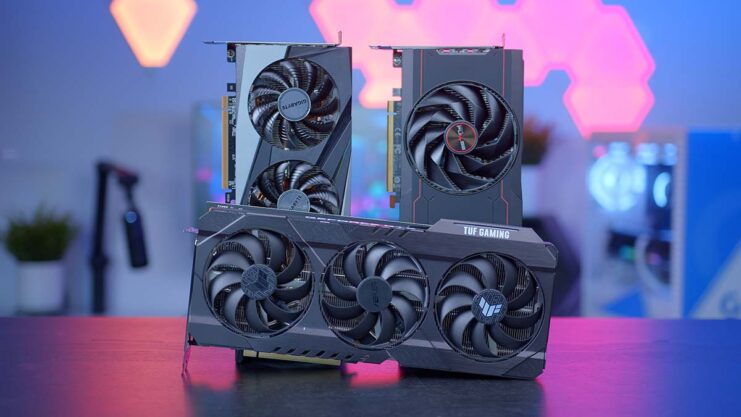In the realm of PC gaming, the graphics processing unit (GPU) is the heart that drives your visual experience. As we set our sights on 1440P gaming, a resolution that strikes a perfect balance between high fidelity and performance, choosing the right GPU becomes crucial.
In this guide, I will simplify your choice in selecting the best GPU for 1440P gaming. If you’re a hardcore gamer seeking the ultimate experience or a casual player looking to upgrade, you’ll find clear, straightforward insights to guide your decision. Let’s begin! My top picks:
- XFX Speedster QICK319 Radeon RX 6750XT – Best for VR
- PNY – NVIDIA GeForce RTX 4070 – Best for eSports titles
- XFX – SPEEDSTER MERC319 AMD Radeon RX 7800XT BLACK – Best for high refresh rate monitors
- MSI – NVIDIA GeForce RTX 3060 Ti – Best for content creation and gaming
- XFX – Speedster MERC319 AMD Radeon RX 6800 XT – Best quality/price ratiO
- Intel Arc A750 Limited Edition – Best budget option
1. XFX – SPEEDSTER QICK319 AMD Radeon RX 6750XT
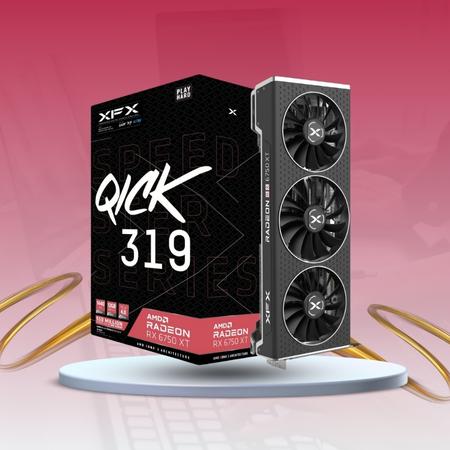
I recently made the switch from an Nvidia 1660 to the 6750XT, and it’s been a game-changer for me. Having done extensive research before making this upgrade, I’ve been using this GPU for a few weeks now, both for work and gaming.
The performance has been impressive. It handles all the latest games like Baldurs Gate 3 and Starfield with ease, delivering stunning graphics at ultra settings and maintaining a smooth 80-90fps without breaking a sweat.
I was initially hesitant to move away from Nvidia after 12 years, but this card has proven its worth, offering what I see as high-end performance at a budget-friendly price. There was a minor hiccup, though. The transition from Nvidia to AMD required a bit of adjustment, especially in terms of software and driver compatibility.
However, this was a small inconvenience compared to the overall experience. The card was also delivered earlier than expected, which was a pleasant surprise. Plus, the seller was quick to provide the AMD bundle key for Starfield after I received the package, adding more value to my purchase.
Key Features
- High VRAM Capacity: 12 GB GDDR6, beneficial for high-resolution gaming and graphic-intensive tasks.
- Advanced GPU Architecture: Utilizes AMD’s RDNA 2 architecture, offering improved performance and efficiency.
- High Clock Speeds: Offers boosted clock speeds (likely around 2600MHz), enhancing gaming and rendering performance.
- Multiple Output Ports: Includes HDMI and DisplayPort outputs, supporting multi-monitor setups.
- Efficient Cooling System: Equipped with a robust cooling solution, often with multiple fans, to maintain optimal temperatures.
- Delivers smooth gaming experiences
- Suitable for virtual reality gaming and applications
- Ideal for high-refresh-rate monitors
- Energy efficient
- Features durable construction with a strong backplate
- May be large in size, requiring a spacious PC case and adequate power supply
2. PNY – NVIDIA GeForce RTX 4070
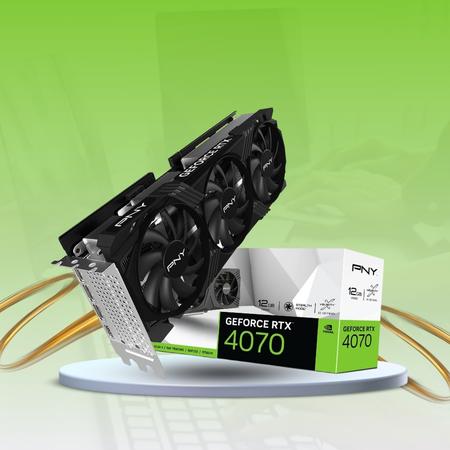
I recently got my hands on the 4070 GPU, and as it turned out, there is a lot to like about it. It’s a powerhouse in terms of performance, boasting cooler temperatures, lower power consumption, and quieter fans, not to mention its compact size.
The improved AI and Ray Tracing features are a dream come true for hardcore PC gamers. If this GPU was priced between $450 and $500, it would be an absolute steal and a must-buy for anyone serious about gaming. However, the $600 price tag gave me pause.
In the same price range, especially in the used market, you can find GPUs like the RX 6950 XT, which offers even more power. After purchasing the 4070, I experienced buyer’s remorse primarily due to its high cost, leading me to return it.
Don’t get me wrong, as a standalone product, the 4070 is fantastic, with many positives and the potential to serve well for years. But if you’re considering this GPU, I’d recommend waiting for a sale or scouring the used market for a better deal.
At its current price, you might find more value and raw performance in other GPUs in the $600 range. Nevertheless, it is a great graphics card, and the features it offers will provide satisfactory performance and incredible visual experience.
Key Features
- GPU Base Clock Frequency: 1.92 gigahertz.
- GPU Boost Clock Frequency: 2.475 gigahertz.
- Cooling System: Equipped with a triple fan setup.
- DisplayPort and HDMI Ports: Includes 3 x DisplayPort 1.4 and 1 x HDMI 2.1.
- Maximum Digital Resolution: Supports up to 8K (4320p) resolution.
- High base and boost clock speeds
- Fan design helps maintain optimal operating temperatures
- Ample ports for diverse display setups
- Capable of handling ultra-high-definition content
- 12GB GDDR6X memory
- PCI Express 4.0 interface
- DLSS 3 technology
- There are other GPUs at a similar price that can compete with or outperform this card
- The RGB software could be more user-friendly or compatible with popular platforms like iCUE.
3. XFX – SPEEDSTER MERC319 AMD Radeon RX 7800XT BLACK
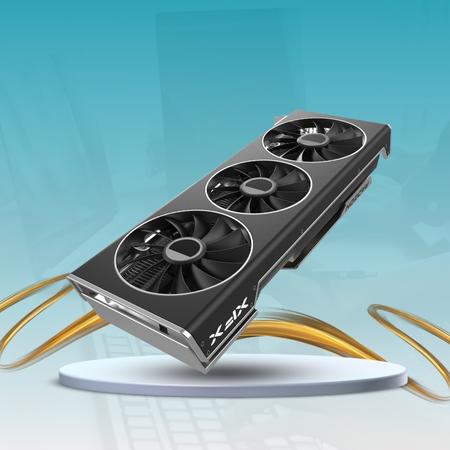
I upgraded my nephew’s machine from a PowerColor Fighter 6700 XT to this new GPU, and the performance was quite impressive. The size of the card is quite substantial, yet it operates surprisingly quietly, which is a big plus for me.
When it comes to performance, this card really delivers. It effortlessly runs demanding games like Hogwarts Legacy and Jedi Survivor on Ultra settings with Ray Tracing enabled and does so smoothly. However, there was a slight hiccup in my experience.
I was supposed to receive a Starfield code with my purchase, but it never came through, and Amazon wasn’t able to resolve this issue. This is worth noting for those who consider the bundled offers as a part of their purchasing decision.
While this card handles ray tracing impressively, I haven’t used an Nvidia card for comparison. But based on its performance with the games I’ve tried, it’s safe to say that this GPU is a solid choice, as long as you’re not too concerned about promotional offers like the Starfield code.
Key Features
- Latest RDNA3 Graphics Architecture: Incorporates AMD’s cutting-edge RDNA3 architecture, offering high performance.
- 5 nm EUV Foundry Process: Built using advanced 5 nm process technology for efficiency.
- 16 GB GDDR6 Memory: Equipped with a substantial memory capacity for demanding games.
- High Memory Bandwidth: Features a 256-bit memory interface with 624 GB/s bandwidth.
- Advanced Cooling Design: Premium custom design with a large aluminum fin-stack heatsink and vapor-chamber plate.
- Ideal for AAA gaming at 1440p resolution
- Efficient cooling and low noise levels
- High-quality components and construction
- Dual-BIOS and factory overclocked
- Compatible with AV1 encode/decode, DisplayPort 2.1, and ray tracing
- Allows for power and frequency adjustments for additional performance gains
- Draws about 250-275 Watts at maximum load
- Audible in an open chassis at extremely high FPS
4. MSI Gaming GeForce RTX 3060 Ti LHR
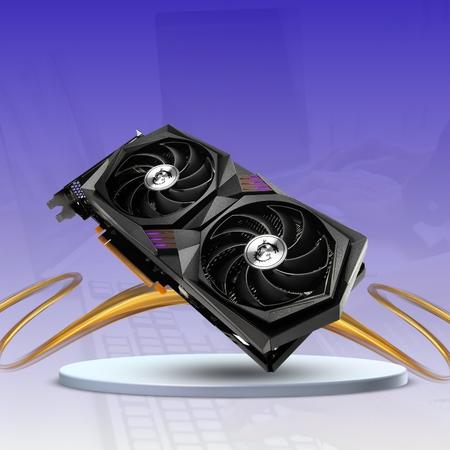
I’ve been using this graphics card in several builds and have found it to be fantastic value for the price. It integrates seamlessly with other MSI components, making it a great choice for those looking to maintain a consistent brand in their builds.
Its performance is solid, especially considering its affordability, making it a go-to option for multiple setups. However, there’s a minor issue with its design. The card has a cosmetic plastic piece on the side that can be a bit of a challenge when mounting in ITX cases.
I initially purchased it for a Fractal Design Meshify 2 Nano build, and fitting it in alongside a radiator was a tight squeeze. I managed to rearrange the radiator to make it work, but it wasn’t ideal. Eventually, I decided to use it in a different build and opted for a Zotac 3070 for the Meshify 2 Nano, which suited that particular setup better.
So, while it’s an excellent choice for its price and compatibility with MSI components, it’s worth considering the case fit and cooling requirements before making your decision.
Key Features
- GPU Base Clock Frequency: 1.41 gigahertz.
- GPU Boost Clock Frequency: 1.695 gigahertz.
- Video Memory: 8 GB GDDR6.
- DisplayPort and HDMI Ports: It comes with 3 DisplayPort ports and 1 HDMI port.
- Maximum Digital Resolution: Supports up to 8K (4320p) resolution.
- Equipped with high-speed G6 memory for efficient performance
- Features the award-winning MSI TORX Fan 3.0 design for effective thermal performance
- A rigid industrial design that fits into any build
- Comes with 4864 CUDA processing cores for enhanced visual realism
- Compatible with a range of systems, including older PCI Express 3.0
- Offers striking graphics with incredible realism
- Powered by NVIDIA’s 2nd gen RTX architecture for demanding games
- No Multi-GPU support
5. XFX Speedster MERC319 AMD Radeon RX 6800 XT CORE
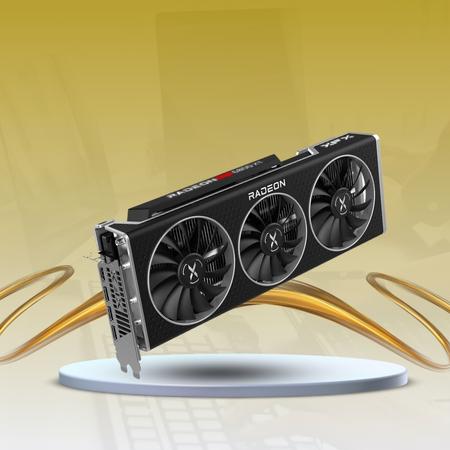
This card, known for its exceptional performance, comes with a powerful triple-slot cooling solution that includes a large aluminum fin-stack heatsink and three fans. Not only does it keep the system cool, but it also runs incredibly quiet, which is a huge plus for me.
XFX has also factory overclocked this GPU, boosting its engine frequency up to 2360 MHz, making it a high-performance choice straight out of the box. However, it’s not without its minor drawbacks.
The card’s substantial size can be a challenge when installing in compact ITX cases. In one of my builds, using a Fractal Design Meshify 2 Nano, it was a tight fit with the radiator installed. While I managed to adjust the setup to accommodate it, the size is something to consider if you have a smaller case.
Key Features
- High-Performance Design: Custom-designed to maximize the performance of the RX 6800 XT, offering high overclocking headroom and an efficient cooler for quiet gaming.
- Advanced Architecture: Built on AMD’s RDNA2 architecture, optimized for real-time raytracing and full DirectX 12 Ultimate compliance for the latest AAA games.
- Powerful Memory: Equipped with 16 GB of GDDR6 memory, operating at 16 Gbps with a 256-bit bus width, enhanced by AMD’s Infinity Cache for improved performance.
- Effective Cooling System: Features a triple-slot cooling solution with a large aluminum fin-stack heatsink ventilated by three fans and a metal cooler shroud for efficient heat dissipation.
- Subtle and Stylish Design: The card has a mostly black cooler with silver highlights and a metal backplate for a sleek, professional look.
- Ideal for maxed-out 4K Ultra HD gaming and high refresh-rate esports gaming
- Utilizes a powerful custom VRM solution and a metal cooler shroud for durability and performance
- Advanced cooling
- Includes a metal bracket to prevent sagging and a protective backplate for durability during installation and handling
- Offers multiple display connections, including DisplayPort 1.4, HDMI 2.1, and USB Type-C with DisplayPort passthrough
- Dual-BIOS feature
- Comes with an increased engine boost frequency for enhanced out-of-the-box performance
- The card is relatively large and heavy, which might require careful consideration for smaller PC builds.
- Needs two 8-pin power inputs and has a high power draw (You can try to undervolt it to reduce power consumption)
6. Intel Arc A750 Limited Edition 8GB
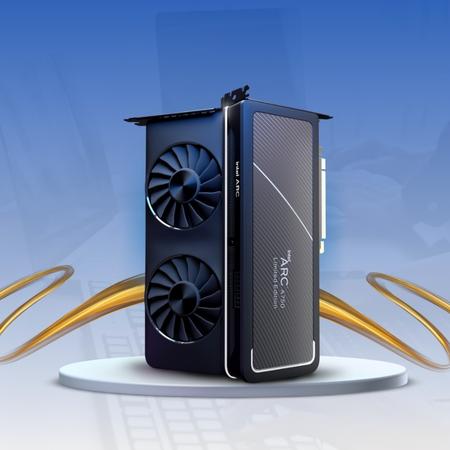
I recently had the opportunity to test out the Intel Arc A750 Limited Edition, and I can conclude that it’s a solid choice for gamers looking for great value for a lower budget. Its performance, both with and without Ray Tracing and Intel XeSS, is genuinely impressive.
In comparison to its rivals, like the GeForce RTX 3050, the Arc A750 stands out, especially considering its more appealing price point. The Ray Tracing performance, in particular, is remarkable, surpassing other cards in its category.
Moreover, the build quality, power utilization, and cooling are exactly what you’d expect from a card in this price range. It’s refreshing to see a graphics card that brings back the sweet spot of the $250 GPU segment, offering top-tier performance in modern games without breaking the bank.
However, it’s not without its minor drawbacks. The Arc A750 requires a Resizable BAR to be enabled for optimal performance, which might not be straightforward for all users. Also, with an 8GB storage capacity, it might feel a bit limited for those looking to push the boundaries of the latest games or for intensive multitasking.
Additionally, its power consumption demands a capable power supply, which could be an extra expense if your current setup isn’t up to the task. But this is a small trade-off considering the overall performance and value this card brings to the table.
Key Features
-
- Architecture: Utilizes Intel Xe-HPG “Alchemist” graphics architecture with ACM-G10 silicon, featuring a 6 nm process and 21.7 billion transistors.
- Core Configuration: The card has 28 Xe Cores across 7 Render Slices, with each core containing 16 Vector Engines and 16 XMX Matrix Engines for high computational power.
- Ray Tracing Technology: Offers real-time ray tracing with technological parity to NVIDIA RTX, leveraging fixed-function hardware for efficient performance.
- Memory Specs: Equipped with 8GB of GDDR6 memory on a 256-bit bus, operating at a data rate of 16 Gbps for a total bandwidth of 512 GB/s.
- Display and Power Connectors: Supports up to two 8K 60 Hz displays or four 4K 120 Hz displays with HDR. The card requires one 8-pin and one 6-pin power connector and has a rated power draw of up to 300 W.
- Priced affordably
- Designed for 1080p and 1440p AAA gaming
- Features Intel’s XeSS technology for high-quality super-resolution upscaling, comparable to NVIDIA’s DLSS and AMD’s FSR
- Full support for DirectX 12 Ultimate, including ray tracing, variable rate shading, and other advanced features
- Sports a visually appealing design
- Includes a vapor-chamber baseplate paired with five heatpipes for effective cooling
- Offers three DisplayPort 2.0 ports and one HDMI 2.1 port, catering to various display needs
- Disassembly is slightly more complicated compared to other brands
- No RGB lighting
- Color mismatch on power connectors
How to Select the Right GPU for 1440p Gaming
Choosing the right GPU for 1440P gaming involves balancing performance, price, and future-proofing. There’s no one-size-fits-all answer, but there are key features to look for.
GPU Memory and Bandwidth
For 1440P gaming, a GPU with at least 6GB of VRAM is recommended. However, 8GB or more is ideal, especially for future-proofing and running games with high-resolution textures.
The memory bandwidth of the GPU also impacts performance, with higher bandwidth offering better handling of gaming textures and resolutions.
Clock Speed and Cores
The clock speed and core count of a GPU directly affect its performance. Higher clock speeds and more cores can significantly improve gaming experiences at 1440P.
However, the balance between core count and clock speed varies between different GPU models, so it’s important to compare them in the context of gaming benchmarks.
Power Consumption and Cooling
Higher performance GPUs often consume more power and generate more heat. Ensure your power supply can handle the GPU’s requirements, and consider the cooling solutions, either within the GPU itself or as part of your overall system cooling strategy.
Cost-Performance Analysis
It’s important to conduct a cost-performance analysis. Sometimes, spending a bit more can significantly enhance performance, making it a worthwhile investment.
Conversely, the most expensive GPUs might offer diminishing returns for your specific gaming needs.
FAQs
Is ray tracing important for 1440P gaming?
Ray tracing, which provides realistic lighting effects, can enhance visual fidelity significantly in games that support it. For 1440P gaming, considering a GPU with good ray tracing capabilities, like NVIDIA’s RTX series, can future-proof your investment and elevate your gaming experience.
However, it’s not a necessity for all games, especially if you prioritize higher frame rates over graphical fidelity.
How does a GPU’s architecture affect 1440P gaming performance?
The architecture of a GPU affects its efficiency and performance. Newer architectures, like NVIDIA’s Ampere or AMD’s RDNA 2, offer improvements in performance per watt, higher clock speeds, and better ray tracing capabilities.
These advancements make them more suited for the demands of 1440P gaming compared to older architectures.
Can I use a multi-GPU setup for 1440P gaming?
While multi-GPU setups (like NVIDIA’s SLI or AMD’s CrossFire) are technically possible, they are generally not recommended for 1440P gaming.
Many modern games don’t support multi-GPU configurations effectively, and the cost-to-performance ratio is often not favorable. A single, more powerful GPU is typically a better choice for both performance and compatibility.
What role does the GPU’s interface (e.g., PCIe 3.0 vs. 4.0) play in 1440P gaming?
The GPU’s interface, like PCIe 3.0 or 4.0, determines the bandwidth available for data transfer between the GPU and the rest of the system. While PCIe 4.0 offers double the bandwidth of PCIe 3.0, the impact on gaming performance at 1440P is currently minimal for most games.
However, PCIe 4.0 can be a future-proofing feature as games and applications continue to evolve.
How important is the GPU driver support for 1440P gaming?
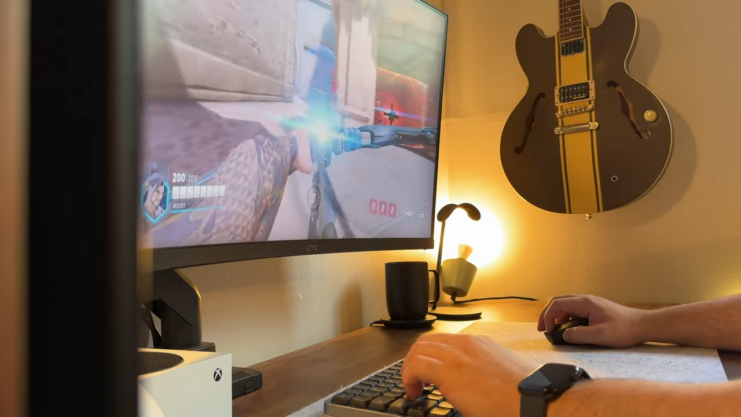
GPU driver support is crucial for optimizing game performance and ensuring compatibility with the latest games. Regular driver updates can improve game performance, add new features, and fix bugs.
It’s important to choose a GPU from a manufacturer with a good track record of regular, reliable driver updates.
Should I consider the GPU’s VR readiness when planning for 1440P gaming?
If you’re interested in VR gaming, it’s important to consider a GPU’s VR readiness. VR gaming can be more demanding than traditional gaming.
A GPU that handles 1440P gaming well is typically also capable of providing a good VR experience, but checking the VRAM, clock speed, and specific VR features of the GPU is advisable for the best VR gaming experience.
Final Words
Selecting the ideal GPU for 1440P gaming is a pivotal decision that shapes your gaming journey. This guide has provided insights and recommendations tailored to help you navigate the diverse market.
Remember, the best GPU for you balances performance, budget, and future-proofing. Whether you’re gearing up for intense gaming marathons or seeking immersive visual experiences, the right GPU will elevate your 1440P gaming to new heights.

